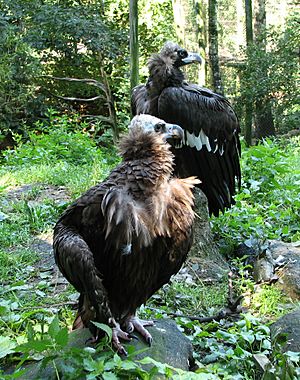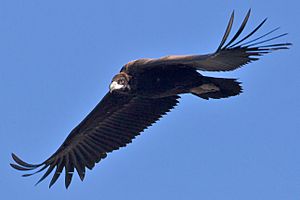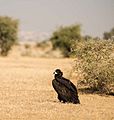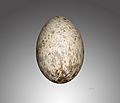Cinereous vulture facts for kids
Quick facts for kids Cinereous vulture |
|
|---|---|
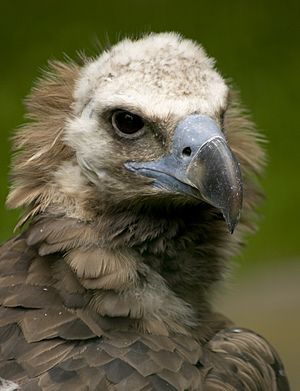 |
|
| Conservation status | |
| Scientific classification | |
| Kingdom: | |
| Class: | |
| Order: | |
| Family: | |
| Subfamily: |
Aegypiinae
|
| Genus: |
Aegypius
|
| Binomial name | |
| Aegypius monachus (Linnaeus, 1766)
|
|
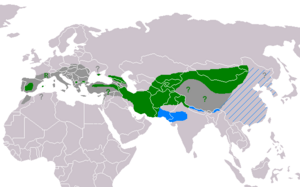 |
|
|
|
The cinereous vulture (Aegypius monachus) is a very large bird of prey. It lives across much of Eurasia, which includes Europe and Asia. People also call it the black vulture, monk vulture, or Eurasian black vulture. This amazing bird belongs to the Accipitridae family. This family also includes other daytime raptors like kites and buzzards.
The cinereous vulture is one of the two biggest Old World vultures. It can weigh up to 14 kilograms (about 31 pounds). Its body can be 1.2 meters (about 4 feet) long. Its wings can spread out to 3.1 meters (about 10 feet) wide! This bird is an Old World vulture. This means it is only distantly related to New World vultures. New World vultures live in a different family called Cathartidae.
Contents
Discover the Cinereous Vulture
Many experts believe the cinereous vulture is the largest true bird of prey in the world. Some birds like condors might be slightly bigger. However, condors are usually not considered true raptors anymore.
This huge bird measures about 98 to 120 centimeters (3.2 to 3.9 feet) long. Its wingspan can reach 2.5 to 3.1 meters (8.2 to 10.2 feet). Male vultures usually weigh from 6.3 to 11.5 kilograms (13.9 to 25.4 pounds). Females are often heavier, weighing from 7.5 to 14 kilograms (16.5 to 30.9 pounds). This makes it one of the heaviest birds that can fly!
The cinereous vulture is mostly dark brown. Its head is a paler color in adults. It is covered with fine, blackish down. The skin on its head and neck is bluish-gray. It is a lighter whitish color above its eyes. Adult vultures have brown eyes and a purplish beak area. Their bill is blue-gray, and their legs are pale blue-gray. When flying, their wide wings are held straight or slightly arched. People sometimes call them "barn door wings" because they are so broad. Their flight is slow and graceful. They flap their wings deeply and heavily when they need to.
Vulture Behavior and Diet
The cinereous vulture is often a solitary bird. You will usually find it alone or in pairs. This is different from most other Old World vultures. They tend to gather in larger groups. However, small groups of cinereous vultures might come together at large feeding spots. These groups rarely have more than 12 to 20 vultures. Some older reports even mention groups of 30 or 40 birds.
What Do Cinereous Vultures Eat?
Like all vultures, the cinereous vulture mainly eats carrion. Carrion is the meat of dead animals. The cinereous vulture eats almost any kind of carrion. This can range from the largest mammals it finds to fish and reptiles.
Among the vultures in its habitat, the cinereous vulture has the strongest bill. This powerful beak helps it tear open tough animal skins. It can even break bones, like ribs, to get to the meat of large animals. It is the boss over other scavengers in its area. This means it can even dominate other large vultures when feeding.
Protecting the Cinereous Vulture
The number of cinereous vultures has gone down in most of its range over the last 200 years. One reason is that they sometimes eat poisoned bait. This bait is often put out to control other animals like dogs. Another reason is that better hygiene standards mean less dead animal meat is left out for them to eat. Because of these challenges, the cinereous vulture is currently listed as "Near Threatened." This means it could become endangered if efforts are not made to protect it.
Images for kids
-
A cinereous vulture flying over Mount Carmel on a rare visit in Israel (2016)
See also
 In Spanish: Buitre negro para niños
In Spanish: Buitre negro para niños



